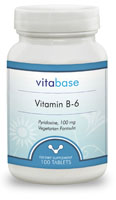| Vitamin B6 (pyridoxine) is found in a wide variety of foods including fortified cereals, beans, meat, poultry, fish, and some fruits and vegetables. Common natural sources of pyridoxine include bananas, carrots, nuts, rice, fish, soybeans, and wheat germ.
Symptoms of pyridoxine deficiency are very non-specific and hard to reproduce. The best sources of vitamin B6 are meats, particularly organ meats, such as liver, and the whole grains, especially wheat. Wheat germ is one of the richest sources. Besides meat, good protein sources of B6 include fish, poultry, egg yolk, soybeans and other dried beans, peanuts, and walnuts. Vegetable and fruit sources include bananas, prunes, potatoes, cauliflower, cabbage, and avocados. As examples of how easily vitamin B6 is lost in the processing of food, raw sugar cane has a good amount, while refined sugar has none; whole wheat flour contains nearly 0.5 mg. of pyridoxine (wheat germ and wheat flakes have much more), while refined wheat flour has almost none, and even whole wheat bread has lost nearly all of its vitamin B6. Herbs that contain vitamin B6 (pyridoxine) include alfalfa, catnip, and oat straw.
Vitamin B6 can be found in multivitamins (including children's chewable and liquid drops), B complex vitamins, or can be sold individually. It is available in a variety of forms including tablets, softgels, and lozenges. Vitamin B6 is also sold under the names pyridoxal, pyridoxamine, pyridoxine hydrochloride, and pyridoxal-5-phosphate. Vitamin B6 is easily destroyed in processing of foods. More than half of the vitamin may be lost with use of the flash-frozen method for freezing fruits and vegetables, during milling of grains, and production of processed meats. Vitamin B6 is not included as part of the enrichment mixture that is added to processed grains to compensate for milling losses so whole grains are a richer source of the vitamin. Fresh meats and raw produce also provide greater levels of Vitamin B6 than their processed counterparts. |
